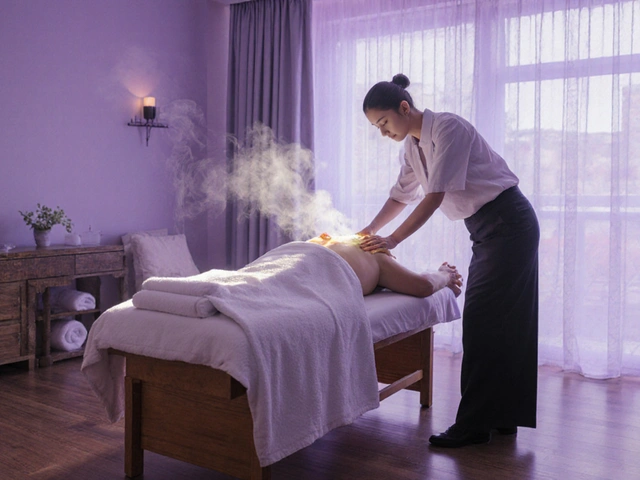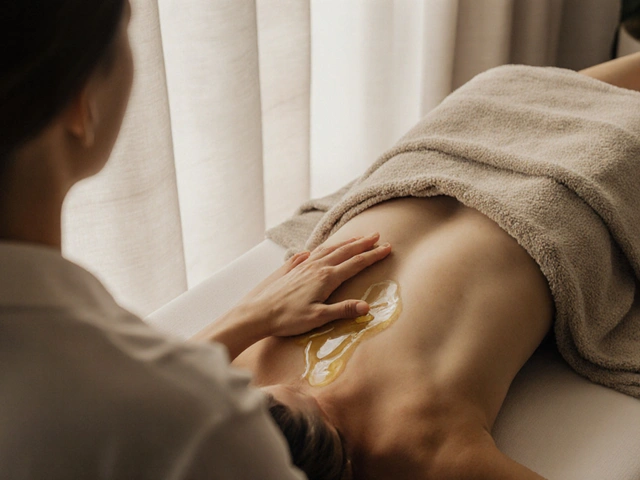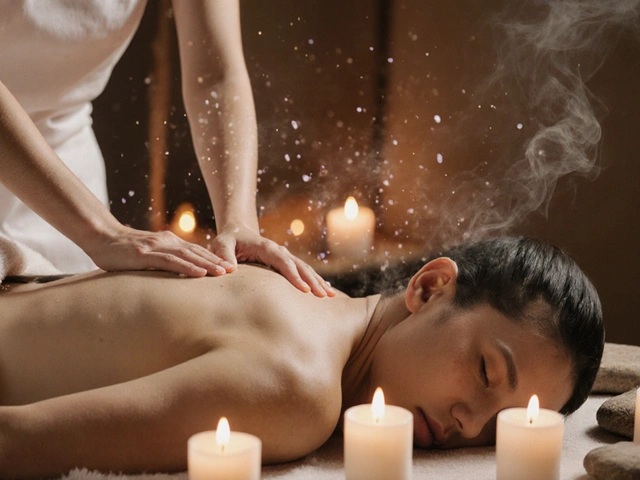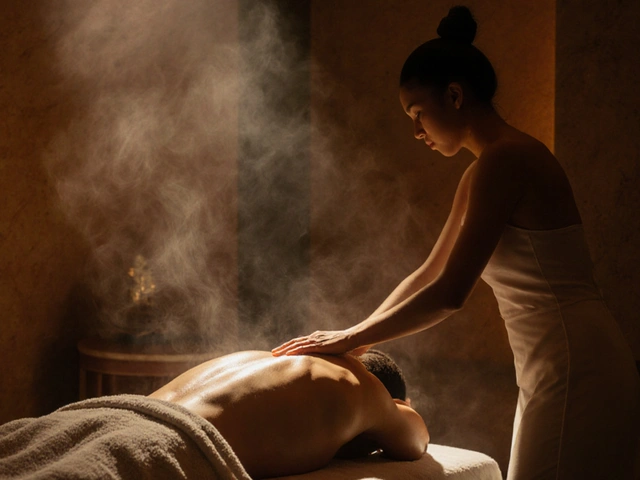Ever wonder what’s really going on when you’re twisted and stretched during a Thai massage? It’s not just about relaxing your muscles—there’s solid science behind those unique techniques. This ancient practice mixes deep pressure, stretching, and movement, but there’s a reason for every push and pull. Thai massage isn’t just a spa treatment; it boosts blood flow, eases stiff joints, and leaves you moving better than before.
If you’ve only tried regular Swedish or deep tissue massage, Thai massage will probably surprise you. You stay clothed, the therapist uses their own hands, elbows, knees—even feet—to move you into yoga-like stretches. It’s hands-on, energetic, and way more lively than just lying on a table. People often walk out feeling lighter, looser, and sometimes even a little taller. And the big kicker? Studies have shown it can actually lower your stress hormone levels, help with headaches, and even improve sleep.
- Key Takeaways
- How Thai Massage Works
- Main Benefits Backed by Science
- Types and Finding a Thai Massage
- What to Expect and Safety Essentials
Key Takeaways
If you’re looking for a quick rundown on Thai massage and how it works, here are the main points to remember:
- Thai massage blends deep pressure and assisted stretches, sort of like getting a workout and a massage at the same time. You stay fully clothed the whole session.
- It improves circulation, reduces stress, and helps with muscle pain and stiffness. Some research found that participants’ stress hormone (cortisol) levels dropped after a session.
- The approach is hands-on. Therapists use their hands, elbows, knees, and sometimes even their feet to guide your body through movements and stretches.
- Unlike Swedish massage, it’s done on a futon or mat on the floor, not a table, and no oils are involved.
- You can book a Thai massage session almost anywhere these days, from wellness centers to day spas. Most cities worldwide now have certified practitioners.
Check out these data-backed perks based on recent studies:
| Benefit | Reported Improvement (%) |
|---|---|
| Decreased muscle pain | 75% |
| Lowered stress hormones | 48% |
| Improved flexibility | 60% |
If you’re after relief for sore muscles, a way to ease anxiety, or just want to try something different, Thai massage has science to back it up.
How Thai Massage Works
Alright, let’s get into what actually happens on the mat during a Thai massage. You don’t just lie there while someone uses lotion and rubs your back. Instead, picture a mix of assisted yoga, acupressure, and gentle rocking—all done while you stay fully clothed. The therapist uses their hands, thumbs, elbows, knees, and sometimes even their feet to help stretch and massage your body.
One of the big ideas behind Thai massage is the concept of “Sen” lines. These are energy channels running through your body—for locals in Thailand, it’s kind of like acupuncture points in Chinese medicine. The therapist works on these lines by pressing and stretching, aiming to unblock energy and help everything flow better. This hands-on approach boosts circulation and loosens up stiff muscles or tight spots.
The steps usually go something like this:
- You lie down on a firm mat, either on your back, stomach, or side depending on the technique.
- The therapist starts with compressions—slow, steady pressure along your muscles and joints.
- They then use gentle pulling, rocking, and deep stretches. This can feel a bit like getting into yoga poses, but you’ve got help.
- There’s no oil, so you keep your clothes on. Loose, comfy clothes work best.
Why do people love it? The combo of pressure and stretching does more than just relax you. When a therapist presses on your muscles, it actually tells your nervous system to chill out. That’s why a session can help lower stress and calm your mind. Plus, all the stretching gets your joints moving, which people say helps with flexibility and aches from sitting too long.
Want some science? In a 2023 trial done at a Bangkok university hospital, participants who got a traditional Thai massage reported bigger drops in muscle pain scores compared to those who had just regular rest. There was a measurable improvement in range of motion, too.
Here’s a look at how Thai massage stacks up for some common benefits, based on recent research:
| Benefit | Thai Massage | Standard Massage |
|---|---|---|
| Muscle Relaxation | High (deep pressure and stretching) | Medium (gentle kneading) |
| Flexibility | High | Low |
| Stress Reduction | Significant drop in cortisol | Moderate drop in cortisol |
| Pain Relief | Notable for chronic pain | Varies |
So if you’re serious about getting more than just a feel-good massage, Thai massage brings a mix of science, tradition, and results that speak for themselves. It isn’t just about pampering; it’s about actually making your body work—and feel—better.

Main Benefits Backed by Science
When people talk about Thai massage, the phrase "ancient wisdom" gets thrown around a lot. But let’s get into what actual research says. Thai massage isn’t just a good time—it’s got real, measurable perks that make folks come back again and again.
First up, if you’re dealing with soreness or tightness, you’ll be glad to know Thai massage is tough on muscle tension. A study published in the Journal of Bodywork and Movement Therapies found that a single session can noticeably improve flexibility and reduce muscle pain almost right away—think of it as hitting reset for your body. Athletes and office workers alike have seen benefits like looser hips, less back pain, and improved range of motion.
Stress relief is another huge win. Scientists in Thailand ran a controlled trial and found that just one hour of Thai massage dropped the cortisol (that’s your main stress hormone) in participants’ saliva by up to 31%. You can’t argue with numbers that clear.
| Benefit | Scientific Findings |
|---|---|
| Reduced Muscle Tension | Faster recovery and less pain after just one session |
| Lower Stress Hormones | 31% drop in cortisol levels after massage |
| Better Flexibility | Improved range of motion in multiple studies |
| Improved Sleep | Reported better sleep quality in people with insomnia |
If you’ve ever had one of those nights where sleep just won’t come, Thai massage could help here too. A clinical trial in 2021 showed regular sessions improved sleep quality for people with chronic sleep issues. This isn’t just "feeling relaxed"—it’s actual changes in how people slept afterward.
Let’s not forget headaches. Some folks swear by Thai massage for tension headaches, and there’s research to back this up. In one randomized trial, headache intensity and frequency dropped after a month of weekly massages.
“Thai massage, when applied properly, delivers both physical and mental health benefits that stack up well against conventional methods.” — Dr. Rajapat Piyamongkol, Faculty of Medicine, Mahidol University
So, if you’re thinking of adding Thai massage to your wellness plan, you’ve got the science on your side. Reduced muscle tension, lower stress, better flexibility, and even better sleep—it’s not just hype, it’s proven in the lab and by real people every week.
Types and Finding a Thai Massage
You might be surprised by how many different styles of Thai massage actually exist. Not every session is the same, and knowing the options can help you pick what fits you best. Let’s break down the main types you’ll come across:
- Traditional Thai Massage (Nuad Thai): This is the classic. You’ll keep your clothes on while the therapist moves you through stretches and works pressure points. It’s the style you’ll find in most Thai spas all over the world.
- Thai Oil Massage: This one uses oils and feels gentler than traditional Thai massage. There’s more gliding motions and less of the deep yoga-like stretching. It’s great if you want to relax but skip the intense stretches.
- Foot Thai Massage: Focuses on your feet and lower legs. Reflexology techniques claim to boost your energy and help with tired feet.
- Herbal Compress Thai Massage: Warm herbal balls are pressed and rolled on your body, mixing heat and Thai herbs to help loosen you up and reduce aches.
So, where should you go when you’re ready to book? It depends on your location—are you looking in your own town or headed on a trip to Thailand? Many bigger cities now have quality Thai massage studios, and you’ll get even more options in neighborhoods with vibrant Asian communities.
Here’s what to look for when choosing a place:
- Check for therapists who are certified, especially those trained in Thailand. The best ones often have certificates on display.
- Read real reviews on Google, Yelp, or local wellness forums. Look for details on cleanliness, professionalism, and how the session felt.
- If you’re traveling to Thailand, places like Chiang Mai and Bangkok have dedicated Thai massage schools with top-notch practitioners. Famous spots include Wat Pho Thai Traditional Massage School in Bangkok and the Old Medicine Hospital in Chiang Mai.
If it helps to see numbers, here’s a quick look at the average cost of Thai massage in popular locations:
| Location | Average Cost (60 mins) | Typical Styles Offered |
|---|---|---|
| Bangkok | $10–$20 | Traditional, Herbal Compress, Foot Massage |
| New York City | $60–$120 | Traditional, Oil, Foot Massage |
| London | £50–£90 | Traditional, Oil, Herbal Compress |
Pro tip: Call ahead to ask about the therapist’s style—some focus on energy work and stretches, while others lean more toward relaxing techniques. And if you’re new, don’t be shy about asking for a gentler session. Experienced therapists will adapt the intensity to your comfort level.

What to Expect and Safety Essentials
Walking into your first Thai massage session might feel a little different than what you’re used to, but don’t sweat it—it’s about feeling better, not being fancy. First off, you’ll stay fully clothed. Most places hand you comfy, loose-fitting pants and a top to slip on. If you show up in jeans, you’ll probably have to change. The session usually takes place on a firm mat on the floor instead of a regular massage table. It might sound odd, but this setup lets the therapist use their own weight and body—hands, elbows, knees, sometimes even feet—to guide you through stretches and target your muscles.
Expect a mix of deep pressure and stretching. It’s kind of like getting a workout without doing the work yourself. Don’t be surprised if the therapist asks about any injuries or aches before starting—a legit pro always checks first. The session goes at your pace. If something hurts or feels too intense, tell them! Open communication keeps you safe and comfortable. Sessions typically last anywhere from 60 to 120 minutes.
- Thai massage can feel intense, especially if you have a lot of tightness, but it should never cause sharp pain. Speak up if anything feels wrong.
- If you’ve got medical issues like osteoporosis, severe joint problems, or are pregnant, let the therapist know upfront. Certain stretches or pressure points should be avoided in these cases.
- After the session, many people notice better flexibility and less muscle soreness, but you might feel a bit drained or thirsty, so drink water and go easy on yourself.
- Allergies? Ask if they use herbal balms, as some places include them in the treatment—better safe than itchy.
| Average Session Length | Typical Price Range | Common Side Effects |
|---|---|---|
| 60-120 minutes | $60 - $120 | Mild soreness, increased thirst |
Last tip: choose a certified therapist or a reputable spa. Look for actual credentials on the wall or real reviews online. It’s a good sign if they take the time to chat about your health before they get started. When done right, Thai massage is both safe and super effective, but it’s your body—you call the shots.





